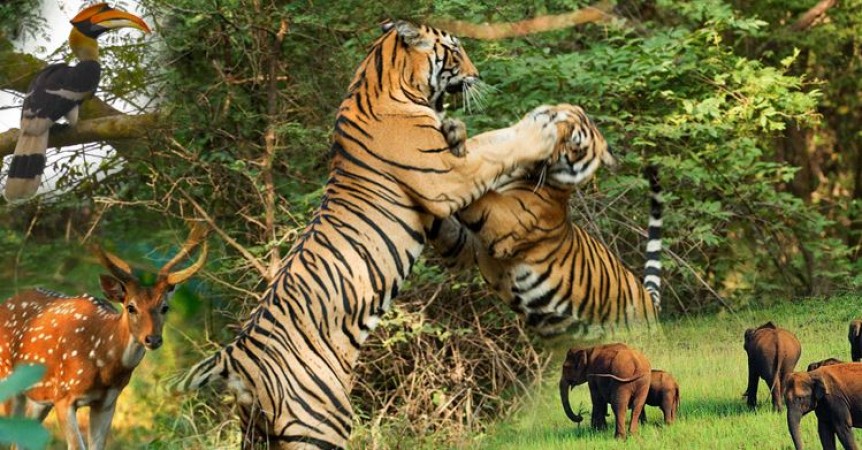
Introduction
India is a country known for its rich and diverse wildlife and natural landscapes. From the mighty Himalayas in the north to the lush forests in the south, India boasts a wide range of ecosystems that support a remarkable variety of flora and fauna. However, rapid urbanization, habitat destruction, poaching, and climate change pose significant threats to the country's wildlife and natural heritage. In this article, we will explore the importance of Indian wildlife and nature conservation and the efforts being made to protect and preserve it.
The Significance of Indian Wildlife Conservation
India is home to a vast array of wildlife species, including Bengal tigers, Asian elephants, Indian rhinoceros, Indian peafowls, and many more. The preservation of these species is crucial for maintaining a balanced ecosystem and ensuring the sustainability of natural resources. Wildlife conservation helps in preserving biodiversity, protecting endangered species, and maintaining the ecological balance.
Threats to Indian Wildlife
Despite the importance of wildlife conservation, Indian wildlife faces numerous threats. One of the major challenges is habitat destruction due to deforestation, urbanization, and industrialization. This leads to the fragmentation of habitats, making it difficult for wildlife to thrive. Poaching and illegal wildlife trade also pose significant threats, particularly for species like tigers and rhinoceros. Climate change further exacerbates these issues, impacting the availability of food and water sources for wildlife.
Protected Areas and National Parks
To safeguard Indian wildlife, the government has established a network of protected areas and national parks across the country. These areas serve as havens for endangered species and contribute to their conservation. Notable national parks in India include Kaziranga National Park, Jim Corbett National Park, and Ranthambore National Park. These parks provide safe habitats for wildlife and promote eco-tourism, raising awareness about the importance of conservation.
Conservation Initiatives and Organizations
Various initiatives and organizations in India are actively working towards wildlife conservation. The Wildlife Protection Act of 1972 serves as the legal framework for the protection and management of wildlife in the country. The National Tiger Conservation Authority (NTCA) focuses specifically on the conservation of tigers and their habitats. Additionally, non-governmental organizations (NGOs) like the Wildlife Trust of India (WTI) and the World Wildlife Fund (WWF) work tirelessly to protect endangered species and their habitats.
Community Involvement in Wildlife Conservation
Engaging local communities in wildlife conservation is crucial for its long-term success. Many conservation programs in India emphasize the involvement of local communities, providing them with incentives to protect wildlife and habitats. These initiatives promote sustainable livelihoods through ecotourism, alternative energy sources, and community-based natural resource management. By involving communities, conservation efforts gain widespread support and ensure the active participation of those living in close proximity to wildlife habitats.
Success Stories in Indian Wildlife Conservation
India has witnessed several success stories in wildlife conservation. The most notable among them is the increase in tiger population. Through dedicated efforts and strict anti-poaching measures, India's tiger population has shown a steady rise in recent years. The reintroduction of the one-horned rhinoceros in Kaziranga National Park is another success story, showcasing the effectiveness of conservation strategies. These achievements highlight the positive outcomes that can be achieved through concerted conservation efforts.
Challenges and Future Perspectives
While progress has been made in Indian wildlife conservation, challenges remain. Rapid human population growth, habitat loss, and climate change continue to threaten wildlife and their habitats. To address these challenges, it is essential to strengthen law enforcement against poaching and illegal wildlife trade, promote sustainable land-use practices, and create awareness about the importance of wildlife conservation among the general public. Collaboration between government agencies, NGOs, local communities, and international partners is crucial for the long-term success of wildlife conservation in India.
Conclusion
Indian wildlife and nature conservation play a vital role in preserving the country's natural heritage and maintaining ecological balance. By protecting endangered species, conserving habitats, and engaging local communities, India is making significant strides in wildlife conservation. However, the challenges that lie ahead require continuous efforts and collaboration from all stakeholders. With collective action and sustainable practices, India can ensure a thriving future for its unique wildlife and natural landscapes.
Indian Travel and Tourism Destinations
Unusual and Quirky Museums Around the World
Scenic Train Rides: Enjoying Picturesque Landscapes on Unforgettable Rail Journeys